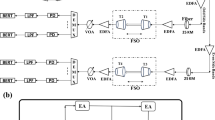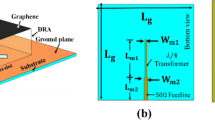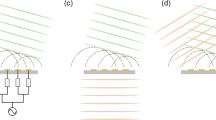Abstract
To improve the power amplifier (PA) energy efficiency, a polarization–amplitude–phase modulation (PAPM) scheme in wireless communication is proposed. The proposed scheme introduces the signal’s polarization state (PS), amplitude, and phase as the information-bearing parameters. Thus, the data rate can be further enhanced on the basis of the traditional amplitude–phase modulation. Also, since the transmitted signal’s PS completely manipulated by orthogonally dual-polarized antennas is unaffected by PA, PAPM can let PA work in its nonlinear region to acquire high PA efficiency. To further optimize the PA energy efficiency based on PAPM, a constrained optimization problem regarding the output back-off value and the ratio between the data carried by the PS and the amplitude–phase is formulated, and the distribution of the optimum solutions is presented. The simulation results show that PAPM can improve the PA energy efficiency significantly.









Similar content being viewed by others
References
Correia L (2010) Chanllenges and enabling technologies for energy aware mobile radio networks. IEEE Commun Mag 48(11):66–72
Birafane A, El-Asmar M, Kouki AB, Helaoui M, Ghannouchi FM (2010) Analyzing LINC systems. IEEE Microw Mag 11(5):59–71
Dinis R, Silva P (2009) Iterative detection of Multicode DS-CDMA signals with strong nonlinear distortion effects. IEEE Trans Veh Technol 58:4169–4181
Kim W-J, Stapleton SP, Kim JH, Edelman C (2005) Digital predistortion linearizes wireless power amplifiers. IEEE Microw Mag 6(3):54–61
Yu Y, Hua Y (2010) Power allocation for a MIMO relay system with multiple-antenna users. IEEE Trans Signal Process 58:2823–2835
Han C, Armour S (2011) Adaptive power and resource allocation strategies for green radio. In: Proc. GLOBECOM
Benedetto S, Poggiolini PT (1994) Multilevel polarization shift keying: optimum receiver struncture and performance evaluation. IEEE Trans Commun 42:1174–1186
Benedetto S, Poggiolini PT (1992) Theory of polarization shift keying modulation. IEEE Trans Commun 40:708–721
Zhuang Z, Xiao S, Wang X (1999) Radar polarization information processing and application. National Defense Industry, Beijing
Pratt T, Walkenhorst B, Nguyen S (2009) Adaptive polarization transmission of OFDM signals in channels with polarization model depersion and polarization-dependent loss. IEEE Trans Wirel Commun 8:3354–3359
Fangfang L, Chunyan F, Caili G, Yue W, Dong W (2010) Virtual polarization detection: a vector signal sensing method for cognitive radios. In: Proceedings of the 71st IEEE vehicular technology conference, VTC Spring 2010. Taipei, Taiwan, 16–19 May 2010
Dardari D, Tralli V, Vaccari A (2000) A theoretical characterization of nonlinear distortion effects in OFDM systems. IEEE Trans Commun 48(10):1755–1764
Rappaport TS (2012) Wireless communications: principles and practice. Pearson Education, Inc, Prentice Hall PTR
Acknowledgements
This work is supported by “Chinese National Nature Science Foundation” (60902047) and “Chinese National Nature Science Foundation” (61271177).
Author information
Authors and Affiliations
Corresponding author
Rights and permissions
About this article
Cite this article
Wei, D., Feng, C. & Guo, C. A polarization-amplitude-phase modulation scheme for improving the power amplifier energy efficiency. Ann. Telecommun. 68, 515–524 (2013). https://doi.org/10.1007/s12243-012-0341-8
Received:
Accepted:
Published:
Issue Date:
DOI: https://doi.org/10.1007/s12243-012-0341-8




